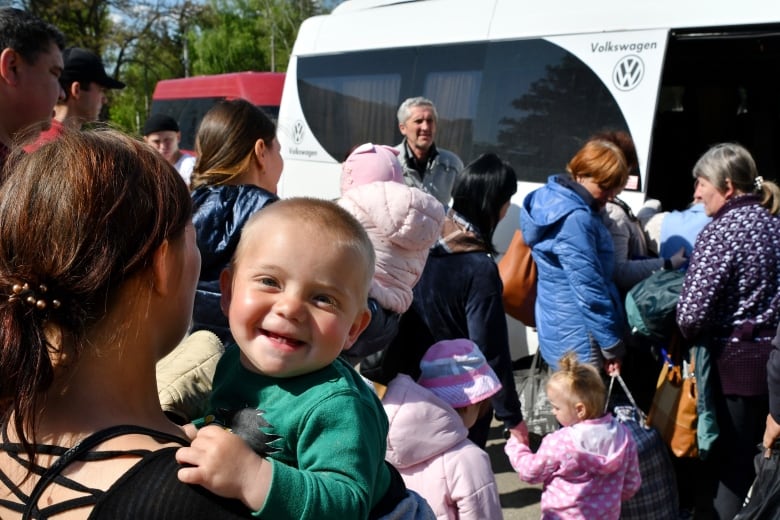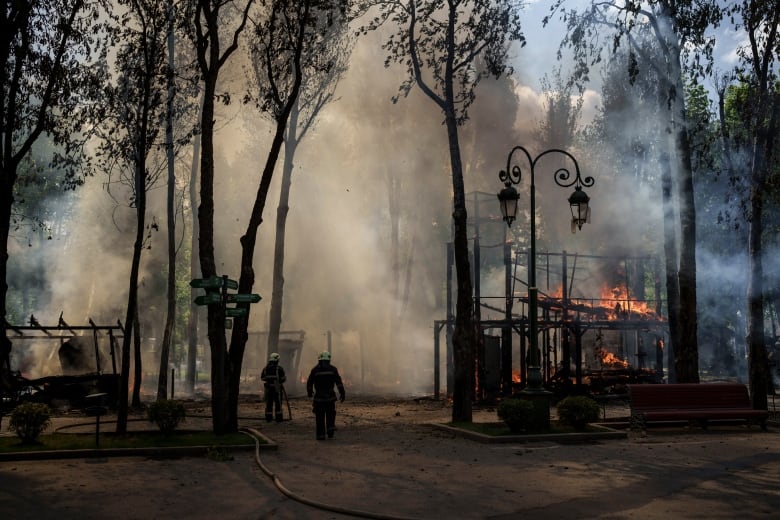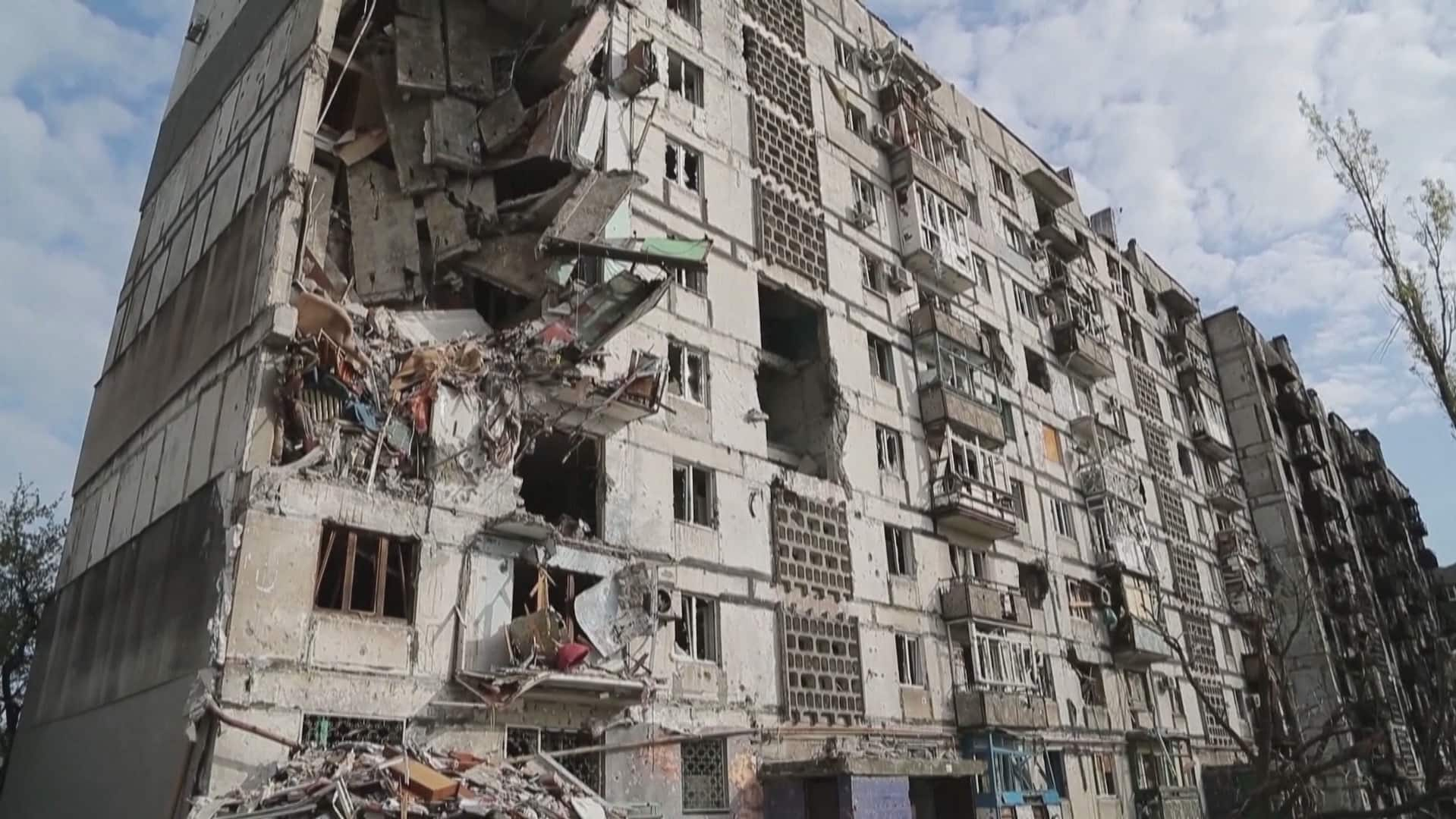Russian forces unleashed artillery fire on towns in eastern Ukraine, killing and wounding dozens of civilians, and began storming the bombed-out steel plant in Mariupol, from which dozens were evacuated after enduring weeks of shelling against the last hotspot of city resistance.
The governor of the eastern Donetsk region said Russian strikes left 21 dead on Tuesday, the highest known death toll since April 8, when a missile attack on the Kramatorsk train station killed at least 59 people.
Adding pressure on Moscow, the European Union leader on Wednesday called on the 27-nation bloc to ban imports of Russian oil in a new wave of sanctions.
European Commission President Ursula von der Leyen outlined what would be the EU’s toughest measures so far, warning the Kremlin “it won’t get away with it.”
101 emerge from steelworks
Thanks to the evacuation effort over the weekend, 101 people, including women, the elderly and 17 children, the youngest six months old, emerged from bunkers under Mariupol’s Azovstal steelworks to “see the light of day after two months,” said Osnat Lubrani. the UN humanitarian coordinator for Ukraine.
Ukraine’s Deputy Prime Minister Iryna Vereshchuk said Wednesday that authorities plan to continue efforts to evacuate civilians from Mariupol and nearby areas if the security situation allows. Lubrani also expressed hope for more evacuations, but said none had been resolved.
One evacuee said that she went to sleep on the floor every night in fear of not waking up.

“You can’t imagine how scary it is when you sit in the bomb shelter, in a damp, wet basement, and it’s bouncing and shaking,” Elina Tsybulchenko, 54, said upon arriving in the Ukrainian-controlled town in Ukraine. Zaporizhzhia, about 230 kilometers northwest of Mariupol, in a convoy of buses and ambulances.
He said that if the shelter were hit by a bomb like the ones that left the huge craters he saw on the two occasions he ventured outside, “all of us would be finished.”
Evacuees, some of whom were crying, stepped off the buses into a tent that offered food, diapers and connections to the outside world. Some of the evacuees searched racks of donated clothing, including new underwear.
Russian storm plant
The news for those left behind was bleaker. Ukrainian commanders said Russian forces backed by tanks have begun storming the sprawling plant, which includes a maze of tunnels and bunkers spread over 11 square kilometers.
It was unclear how many Ukrainian fighters were still inside, but the Russians put the number at around 2,000 in recent weeks, with 500 reportedly wounded. A few hundred civilians also remained there, Ukrainian Deputy Prime Minister Iryna Vereshchuk said.
“We will do everything possible to repel the assault, but we call for urgent measures to evacuate the civilians who remain inside the plant and get them out safely,” said Sviatoslav Palamar, deputy commander of Ukraine’s Azov Regiment. Telegram messaging application.
He added that throughout the night, the plant was attacked with naval artillery fire and air strikes. Two civilian women were killed and 10 civilians were wounded, he said.
In his late-night video address, Ukrainian President Volodymyr Zelensky said that by storming the steel plant, Russian forces violated agreements for safe evacuations. He said the previous evacuations “are not a victory yet, but it is already a result. I think there is still a chance to save other people.”
Among those killed in fresh artillery attacks in Donetsk on Tuesday were 10 people at a chemical plant in the city of Avdiivka, Donetsk Governor Pavlo Kyrylenko said.
‘Another cynical crime’
“The Russians knew exactly where to target: the workers had just finished their shift and were waiting for a bus at a stop to take them home,” he wrote in a Telegram post. “Another cynical crime of the Russians on our land.”
Two other civilians were killed and two wounded during overnight shelling in the neighboring Lugansk region, Gov. Serhiy Haidai said, adding that Russian attacks were intensifying.
Just to the north, near the strategic crossroads of the city of Izyum, Russia has deployed 22 battalion tactical groups as it seeks to advance along Donbas’s northern axis, the British Ministry of Defense said on Wednesday. Each unit usually has about 700 soldiers.
CLOCK | The UN-led evacuation of Mariupol will continue:
The first convoy of civilians to escape a decimated steel plant in Mariupol, Ukraine, reached relative safety in a Ukrainian-controlled city. Deputy Prime Minister Iryna Vereshchuk told reporters that a few hundred civilians remain at the plant. 2:19
Despite struggling to break through Ukrainian defenses and build momentum, Russia likely intends to advance beyond Izyum to capture the cities of Kramatorsk and Severodonetsk, according to the British assessment, and encircle Ukrainian troops in the region of Kharkiv. However, Moscow’s momentum has been slow as Ukrainian fighters dig in and use long-range weapons, such as howitzers, to attack the Russians.
The United States believes the Ukrainians in recent days have pushed Russian forces some 25 miles east of Kharkiv, the country’s second-largest city. Extending the distance from the front line makes it more difficult for Russia to target the city with artillery fire. Ukrainian authorities said that over the past week their forces have regained control of at least 11 villages around Kharkiv, most of them held by the Russians for more than two months.
The industrial heartland of eastern Ukraine, Donbas, which includes Donetsk and Luhansk, remains Moscow’s declared target after failing to take kyiv in the first weeks of the war.
Explosion in Lviv
Explosions were also heard in Lviv, in western Ukraine, near the Polish border. The attacks damaged three electrical substations, cut power to parts of the city and cut off water supplies, injuring two people, the mayor said. Lviv has been a gateway for NATO-supplied weapons and a haven for those fleeing fighting in the east.
Russian Defense Ministry spokesman Major General Igor Konashenkov said Russian aircraft and artillery hit hundreds of targets the day before, including troop strongholds, command posts, artillery positions, fuel and ammunition depots and radar equipment.
Ukrainian authorities said the Russians also attacked at least half a dozen railway stations across the country.

The assault on the Azovstal steel plant began nearly two weeks after Russian President Vladimir Putin ordered his military not to storm the plant to finish off defenders, but instead to blockade it. The first civilians evacuated from the shattered plant left during a brief ceasefire in an operation supervised by the UN and the Red Cross.
Some of the elderly evacuees seemed exhausted when they arrived. Some of the younger people, especially the mothers comforting their babies and other children, seemed relieved.
“I am very happy to be on Ukrainian soil,” said a woman who gave only her first name, Anna, and arrived with two children, ages 1 and 9. “We thought we weren’t going to get out of there, frankly speaking. .”
Reference-www.cbc.ca
